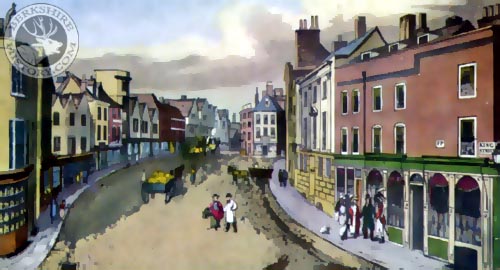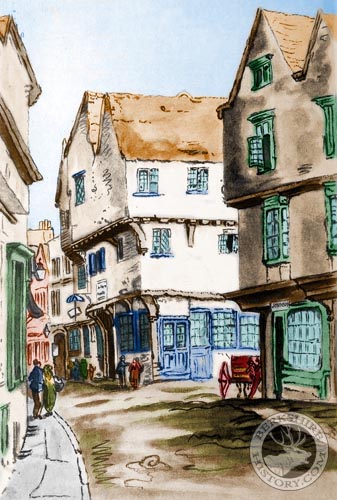 |
 |
|||||||||||||||||||||||||||||||||||||||||||||||||||||||||||||||||||||||||||||||||||||||||||||||||||||||||||||||||||||||||||||||||||||||||||||||||||||
|
In 1812, Sherwood was one of eighteen different businessmen listed as living in King Street (although some of them may have been in partnership at the same address and there may have been other businesses where the owner was not in residence). The illustration above is broadly contemporary, although its exact date is unknown.
Linen draperies were still popular in the street. John Gill took over his linen drapery business from Jonathan Tanner (1756-1835) at No. 24 in 1793. By 1827, it was in the hands of Thomas Gill. It was probably either Mr. Bailey or Mr. White's shop that was at No. 1-2 (and 14 High Street which was the official name of the eastern end). These 'extensive premises,' on the 'corner of...High Street' were J. Armstrong's drapery in the late 1810s. However, in September 1820, the same business reopened there as Armstrong, Williams & Co. By 1827, it was being run by George & Thomas Weston. They may have later moved to the High Street, as, on 19th March 1831, it was reopened again as Thomas Armstrong's drapery, hosiery & haberdashery (ribbons & silk goods generally) with a particularly "extensive assortment of straw bonnets of all descriptions" including Tuscan, Dunstable and Devonshire styles. He had previously been at 15 High Street where he had operated for ten years. He later became known for his bargains and cheap prints and the shop was referred to as 'Armstrong's Cheap Drapery Warehouse'. Thomas Armstrong retired in June 1837. Soon after Gill bought his linen business, Tanner moved into brewing by purchasing the Castle Brewery in Castle Street. He may have been a relation of William Tanner, the victualler. William was probably the landlord at the Shoulder of Mutton at No. 4, now the western part of the old bank with the elaborate entrance. Nathaniel Hone (1767-1824)’s ‘inn’ must have been the George which is still there today at Nos. 10-11. Although, the the main wing or rooms are behind Nos. 12-13, so in 1827 we find George Tight described as a jeweller & watchmaker at No. 11, while the George is given as No. 12. The George had an associated ‘General Coaching Office’ run from the inn, and, by 1827 the Hones were running this side of the business alone, as Thomas Edwards was at the inn itself. Mrs. Mason was installed as landlady ten years later. William Hone (1793-1872) – possibly a nephew – ran the ‘Royal Dart Post Coach’ daily to Oxford via Wallingford, Dorchester & Abingdon for passengers and parcels. John Truss also ran coaches from George. There was also a rival coaching business, Samuel & Thomas Williams, started in 1806, that opened offices next door at No. 9 sometime before 1827. They soon moved across the road to No. 7 (and later No. 5), when this was vacated by George Budd Hetherington (1802-1873) & Charles Strudwick (1789-1862), the woollen draper partners who had been there since 1823, but now moved to No. 22. The coaches themselves were run out of Southampton Street (by Thomas) and London Street (by Samuel (1768-1842)). The Williams Brother's London Coaching Office ran daily coaches to and from the Black Lion in Water Lane off Fleet Street (London), via Wokingham, Binfield, Bracknell & Sunninghill. Both men lived in different houses in Castle Street, but supposedly joined forces in 1835. The Williams brothers rented their coaches from John Brown, a coach builder also in Castle Street, but the five year arrangement was not without its disputes because it was not clear if the partnership was genuine or if the two brothers ran coaches independently of one another. By 1837, the London Coach Office was shared with the Berkshire Chronicle which had moved from the High Street in 1832. Whatley Solicitors, originally Whatley & Bickham, had been next door since 1830. John Church, the Auctioneer, had also been at No. 16 since 1827. John Sutton (1777-1863) founded a corn dealing business at No. 13 in 1806. He concentrated on trading in corn, flour, malt and hops, but his son, Martin Hope Sutton (1815-1901), recognised the lack of potential expansion available and, against his father’s wishes, developed a successful side-line in garden seeds during the 1830s. This was to become the World-famous company of Sutton Seeds upon their move to the Market Place in 1837. The major firm that is not mentioned in 1812, is the Simonds’ Bank which was not founded at No. 3 King Street until 1814. It was originally known as the Simonds & Nicholson Bank, having been set up by the brewer, William Blackall Simonds (1761-1834), his son and cousins, along with Ralph Nicholson. Blackall Simonds and Nicholson retired two years later, but Henry (1785-1874), John (1765-1845) and Charles Simonds (1767-1859) continued with the business. Henry ran a wine merchants business from the same premises. James Rusher & Co were at No. 14, where he sold “almanacs, pocket books, repositories, souvenirs, keepsakes and all the other annuals and new publications in a variety of elegant and other bindings, adapted for presents. As also a large collection of books, new and second-hand… paper, pens, sealing-wax and all kinds of stationery articles of the best quality” Thomas Okey had opened his grocery store at No. 21 by 1827. Daniel Terriere was at No. 22, where his son, William, was also operating their boot & shoemaking business by 1827. John Tutty, the grocer, was next door at No. 23. His son, Henry Tutty (1803-1862), joined him as a partner in about 1824 and they began to diversify into baking. Henry later specialised in baking and confectionary. Edmund Philips was a silversmith & jeweller at No. 25, on the corner of Duke Street, in 1827 (also, bizarrely, dealing in tea). This is a business that has continued at this location to the present day, although under a number of different companies. Around 1833, George Botly had taken over, founder of a firm that was well-known throughout the Victorian era.
"These [Nos. 8-9] quaint old houses [were] occupied by Mr. Horniman, umbrella manufacturer. He was a member of the Society of Friends, and during the war in the Peninsula frequently called at our house, and from there adjourned to a large room where the Times newspaper was usually read aloud. Mr. Horniman called frequently upon my father and was very kind to me. He used to admire my canaries, and he said, "I should like to buy one of your young birds to make a present." I sold him one for 5/- and as time passed he often said, "Thy bird don't sing, William." I expressed my regret. At last he said, "I think thee has taken me in." This was a little too much for my pride, and I saucily said I thought his people were not fond of music. I lost Mr. Horniman's patronage from that moment, and was punished by my Pater by having the rest of my birds taken from me." Thomas died in 1817 and his widow, Hannah, remarried to Thomas Smith (1760-1843). Horniman's son, Robert, was a printer at 66 Broad Street and produced 'Horniman's Reading Directory' in 1827. His brother, John, was a tea-dealer in Bridge Street before founding the well-known firm of Horniman's Tea on the Isle of Wight in 1826. Presumably the two maintained an interest in the umbrella business as the Horniman name was retained there. In 1829, the beautiful old Tudor shop was demolished and rebuilt as we see it today. The partners then expanded the business to include corsets and the firm continued there as Smith and Horniman, latterly under the guidance of Smith's daughter, Hannah, until his own demise in 1843. “On Monday last [11th February 1829] commenced the pulling down of the houses in King Street and Minster-street, which formed the angle so well known by the appellation of Horniman's Corner. The progress of the operation was watched with more than common interest from the universal feeling that this was the first instance in which the Reading Improvement Act had been applied to a purpose of public utility. Expectations had naturally been formed that ancient coins would be found; but we have not heard of any which could be carried back further than 1591 (temp. Elizabeth)” By 1837, the Street’s occupants looked like this:
Additional information on Georgian King Street businesses is always gratefully received. Please email me at nashfordpublishing@googlemail.com Click onwards for Notes on
Victorian King Street
|
|||||||||||||||||||||||||||||||||||||||||||||||||||||||||||||||||||||||||||||||||||||||||||||||||||||||||||||||||||||||||||||||||||||||||||||||||||||
| © Nash Ford Publishing 2016. All Rights Reserved. | ||||||||||||||||||||||||||||||||||||||||||||||||||||||||||||||||||||||||||||||||||||||||||||||||||||||||||||||||||||||||||||||||||||||||||||||||||||||





 In 1800, Skinner & Hooper opened a tobacco factory in King Street, one assumes on the south side where there was room behind the shops, north of Yield Hall Place. William Hooper seems to have been running the business alone when they went bust twelve years later. The Hoopers were a family of well-known surgeons in the town. Around the time of the factory opening, Dr. John Hooper Junior (1764-1842) was practicing in King Street. He was an expert in ‘diseases of the eye’. In 1837, his son, William Hooper (1805-1844), was also a tobacconist at 128 London Street, so presumably they were related to the first William in some way. From at least 1830, William’s cousin, Dr. Frederick Blissett Hooper (1802-1854), was operating out of No. 18 (and later No. 17) King Street, in partnership with Maurice Harris as Messrs. Harris, Hooper & Co. This is the tall narrow white building, now Sara Batting Estate Agent, which has barely changed. Dr. Richard Sherwood (1783-1862) may have operated out of the same premises before them. He was one of the Sherwoods of Purley and had a country estate at Chaddleworth House, near Hungerford. His wife was daughter of the Reading brewer and banker, William Stephens.
In 1800, Skinner & Hooper opened a tobacco factory in King Street, one assumes on the south side where there was room behind the shops, north of Yield Hall Place. William Hooper seems to have been running the business alone when they went bust twelve years later. The Hoopers were a family of well-known surgeons in the town. Around the time of the factory opening, Dr. John Hooper Junior (1764-1842) was practicing in King Street. He was an expert in ‘diseases of the eye’. In 1837, his son, William Hooper (1805-1844), was also a tobacconist at 128 London Street, so presumably they were related to the first William in some way. From at least 1830, William’s cousin, Dr. Frederick Blissett Hooper (1802-1854), was operating out of No. 18 (and later No. 17) King Street, in partnership with Maurice Harris as Messrs. Harris, Hooper & Co. This is the tall narrow white building, now Sara Batting Estate Agent, which has barely changed. Dr. Richard Sherwood (1783-1862) may have operated out of the same premises before them. He was one of the Sherwoods of Purley and had a country estate at Chaddleworth House, near Hungerford. His wife was daughter of the Reading brewer and banker, William Stephens. No 8 King Street, on the
corner of Minster Street, was the location of Thomas Horniman (1766-1817)’s
umbrella shop, generally known as Horniman's Corner. William Silver Darter later
recalled:
No 8 King Street, on the
corner of Minster Street, was the location of Thomas Horniman (1766-1817)’s
umbrella shop, generally known as Horniman's Corner. William Silver Darter later
recalled: